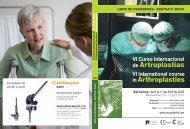cadera / hip - Active Congress.......
cadera / hip - Active Congress.......
cadera / hip - Active Congress.......
Create successful ePaper yourself
Turn your PDF publications into a flip-book with our unique Google optimized e-Paper software.
VIERNES / FRIDAY<br />
256<br />
sive lateral facet resection)<br />
2. Treatment (based on etiology)<br />
a. Lateral retinacular release / VMO<br />
advancement<br />
b. Tibial tubercle transfer<br />
c. Capsular repair<br />
d. Component revision if malpositioned<br />
3. Intraoperative analysis<br />
a. Rule of No Thumb<br />
b. Release of tourniquet to assess extensor<br />
mechanism balance<br />
B. Patellar Fracture<br />
1. Multiple etiologies<br />
a. Trauma<br />
b. Improper patellar resection (excessive,<br />
insuffi cient, asymmetric)<br />
c. Large central fi xation lug<br />
d. Patellofemoral instability (eccentric<br />
loading)<br />
e. Avascular necrosis<br />
1) Intraosseous / extraosseous vascular<br />
disruption<br />
2) Prevention<br />
a) Maintain fat pad and LSGA<br />
b) Avoid large central lug hole<br />
f. Excessive fl exion (increased loads /<br />
activity levels)<br />
g. Component malposition<br />
h. Thermal necrosis (PMMA)<br />
2. Treatment<br />
a. Nonoperative<br />
1) Nondisplaced fractures<br />
2) Displaced without extensor lag<br />
3) No dislocation / loosening<br />
b. Operative<br />
1) Displaced with extensor lag<br />
2) Poor results<br />
C. Patellar Component Loosening<br />
1. Etiologies<br />
a. Instability<br />
b. Cementation into defi cient bone<br />
c. Excessive body weight / activity levels<br />
2. Treatment<br />
a. Observation<br />
b. Component revision or removal<br />
c. Patellectomy<br />
D. Patellar Component Failure<br />
1. Polyethylene wear / fracture<br />
a. Contact pressures routinely exceed<br />
UHMWPE yield strength<br />
b. Malalignment = Increased loads<br />
c. Metal backing = reduced polyethylene<br />
thickness<br />
2. Polyethylene/plate dissociation<br />
a. No chemical bonding<br />
b. Excessive wear / loss of mechanical<br />
grip<br />
3. Peg/plate dissociation<br />
a. Good peg ingrowth<br />
b. Variable plate ingrowth<br />
c. High shear @ peg/plate junction<br />
4. Multiple clinical studies<br />
a. Metal-backed failures predominate<br />
b. Often unsuspected preoperatively<br />
c. Failure with multiple designs<br />
d. Early failure common (2 to 4 years)<br />
e. Be prepared to revise all components<br />
if metal-backed design present<br />
1) Femoral/tibial component damage<br />
often coexisting<br />
5. Risk factors<br />
a. Excessive body weight/activity levels<br />
b. Enhanced knee fl exion (>115°)<br />
c. Male gender<br />
d. Patellofemoral malalignment<br />
e. Oversized/flexed femoral components<br />
f. Joint line malposition<br />
E. Patellar Clunk Syndrome<br />
1. Anterior “clunk” on knee extension @<br />
30-45°<br />
2. Suprapatellar nodule - catches in intercondylar<br />
notch<br />
3. Pathogenesis: quadriceps tendon impingement<br />
a. Small patellar component<br />
b. Superior component malposition<br />
c. Abrupt change in radius of curvature<br />
of femoral component<br />
d. Sharp superior edge (intercondylar<br />
notch)<br />
4. Treatment<br />
a. Nodule excision (open vs. arthroscopic)<br />
b. Patellar component revision (cau-





